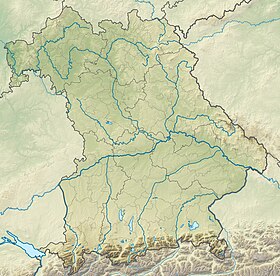Horseradish
Krenland (on the map of Bavaria) |
Coordinates: 49 ° 39 '30 " N , 11 ° 1' 40" O Krenland is a local landscape designation in Regnitztal between Forchheim and Erlangen . Already in the 15th century there was a specialization in the cultivation of aromatic and medicinal plants, the name of the region was given by horseradish (southern German: horseradish ). The Margrave Johann von Brandenburg-Kulmbach (called the alchemist) is said to haveparticularly encouragedhorseradish cultivation here and in the Knoblauchsland .
The first written mention of horseradish cultivation in Franconia comes from the book "Die Nymphe Noris" published in 1650. There it is listed among the cultivated vegetables in the description of the garlic country. The first evidence of cultivation in the Baiersdorf area comes from Johann Michael Füssel's travel diary and relates to the year 1788. At the beginning of the 19th century, horseradish cultivation around Baiersdorf was of great economic importance. In the Montgelas statistics from 1811/12: “In the village of Baiersdorf was also built: 12 Metz fruits, the proceeds of 50 florins p. M., 8 Metz Kardeln , the proceeds of 50 florins p. M., 751 Metz horseradish, the proceeds p. M. for 70 fl. For 5250 fl. ”From the middle of the 19th century, horseradish cultivation slowly increased. After the opening of the Nuremberg-Bamberg railway line in 1844 and the Ludwig-Danube-Main Canal in 1846, the horseradish produced could be transported cheaply. For 1894 the total amount of kren produced in the area around Nuremberg and Fürth was estimated at 50,000 hundredweight . About 30,000 quintals were sent annually by the wholesalers by rail, 10,000 quintals were shipped to Austria. From around 1870, some of the harvest was sold by peddlers and horseradish women throughout southern Germany. The First and Second World Wars led to a temporary decline in horseradish cultivation, as the state fixed prices made it less lucrative.
In Baiersdorf there is a horseradish museum , which also shows the importance of horseradish cultivation in the region.
Individual evidence
- ↑ Objectives for the individual sub-areas: H 100.1. (No longer available online.) Regional Planning Association Upper Franconia-West, archived from the original on June 6, 2009 ; Retrieved March 4, 2010 . Info: The archive link was inserted automatically and has not yet been checked. Please check the original and archive link according to the instructions and then remove this notice.
- ↑ Karin Weber, Andreas Otto Weber: Tours through village and hall: Eating and drinking in earlier times. Friedrich-Alexander-Universität Erlangen-Nürnberg , Department of History, Chair for Bavarian and Franconian Regional History, September 9, 2001, archived from the original on May 9, 2012 ; Retrieved March 4, 2010 .
- ^ Günter Heinritz: The "Baiersdorfer" Krenhausierer . Published by the board of the Franconian Geographical Society, Erlangen 1971
